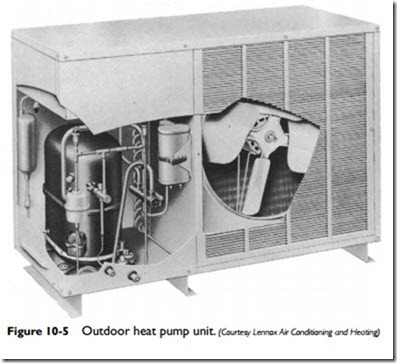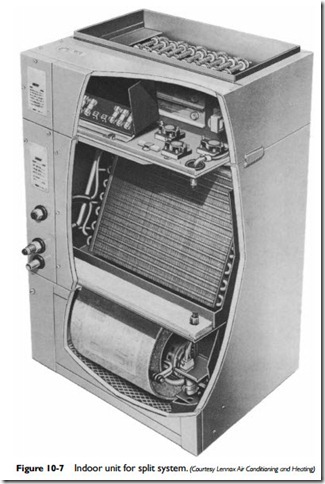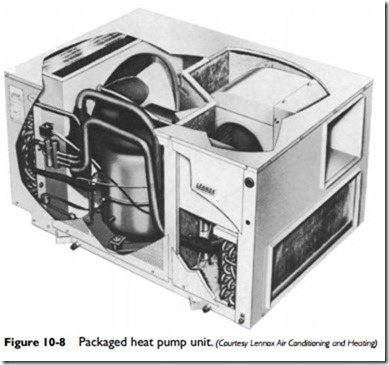Types of Heat Pumps
Heat pumps are often classified according to their heat source. The three principal types used in residential and light commercial heat- ing/cooling systems are: (1) air-source heat pumps, (2) ground- source heat pumps, and (3) water-source heat pumps.
Air-Source Heat Pumps
An air-source heat pump (also sometimes called an air-to-air heat pump) relies on the outdoor air as the heat source. In other words, it extracts the heat from the outdoor air and transfers it to the rooms and spaces inside the structure. A major technical problem associated with earlier air-source heat pumps was that the tempera- ture of the outdoor air is commonly lowest when heat requirements are highest—that is, during the cold winter months. When outdoor temperatures drop below 0°F, the heat pump is largely ineffective. For this reason, some sort of supplementary radiant heating system was usually employed until outdoor air temperatures rose to a level suitable for effective use of the heat pump.
Note
Air-source heat pumps operate most efficiently in areas where the winter temperatures usually remain above 30°F. In climates where the winter temperatures frequently drop below freezing, a backup auxiliary heater must be used with an air-source heat pump. Ground-source heat pumps are more efficient and economical to operate than conventional air-source units in areas with similar heating and cooling loads.
Split-System Heat Pumps
Most air-source heat pumps used in residential and light-commercial heating and cooling systems are split-system heat pumps. A split- system heat pump is so called because its components are divided into two sections, one located indoors and the other outdoors. The two sections are connected by refrigerant tubing. In most split-system heat pumps, the evaporator coil, blower, and filter section are located inside the structure, and the compressor, condenser coil, and fan are located outdoors (see Figures 10-5, 10-6, and 10-7).
Sometimes the outdoor condensing section is installed on the roof and the indoor section is suspended from the ceiling. This is a very common type of installation in commercial buildings.
In residential installations, the outdoor section is usually placed on a concrete slab next to the house and the indoor section is located either in the attic (installed horizontally) or in a closet space (installed vertically) on the same level as the outdoor unit.
Packaged Heat Pumps
Some air-source heat pumps are packaged units. A packaged heat pump differs from the split-system heat pump by having the condenser coil, evaporator coil, compressor, blower and motor,
automatic controls, and filter all located in the same box (see Figure 10-8). Some packaged heat pumps are used with ductwork to heat and cool the entire house; others do not use ductwork because they are designed to heat and cool only a single room and do not require ducts. These heat pumps are also referred to as single-packaged units, through-the-wall units, or self-contained heat pumps by various manufacturers.
Advantages and Disadvantages of Air-Source Heat Pumps Most residential heat pumps are the air-source type installed as a split system with the compressor and outdoor coil installed outside the structure and the indoor coil installed inside. Because their use is so widespread, replacement parts are easy to acquire and trained, certified technicians are readily available in most areas of the country.
The air-source heat pump is less expensive to install than the ground-source or water-source heat pumps. On the other hand, it is noisier than either of the other types, is more difficult to conceal, and requires more maintenance.



